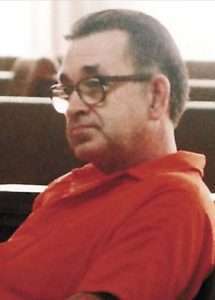George Wallace was executed by the State of Oklahoma for two murders
According to court documents George Wallace would murder Mark Anthony McLaughlin, 14, and William Eric Domer, 15, days apart and would also murder Alonzo Don Cade, 12,. While in prison Wallace would confess to two more murders that took place in North Carolina. Wallace would also attempt to murder another man and would also take four teenagers hostage
George Wallace would be arrested, convicted and sentenced to death
George Wallace would be executed by lethal injection on August 10 2000
George Wallace Photos

George Wallace FAQ
When Was George Wallace Executed
George Wallace was executed on August 10 2000
George Wallace Case
On December 10, 1990, George Wallace, then age 50, from Fort Smith, Arkansas, was arrested. He was charged with the December 9, 1990, kidnapping and attempted murder of Ross Allen Ferguson, 18. Ferguson escaped despite multiple stab wounds and being bound in handcuffs and leg irons. Wallace was held on a $1.5 million bond.
Police reports indicate that Ferguson was picked up in a grocery store parking lot in Van Buren, Arkansas, by a man who posed as a police officer. He was then taken to a pond east of Greenwood. Ferguson fled his kidnapper after being stabbed at least six times. He pretended to be dead, then jumped up and pushed down his attacker. Ferguson ran to the car and left his attacker stranded at the pond. He reached a home where residents called the police. Ferguson was taken to a hospital where he was in stable condition. Wallace was arrested later that night walking in the area of the abduction. Ferguson identified him in a lineup. Isidro Hernandez, 19, also reported that a man claiming to be a police officer tried to pick him up, but Hernandez said he “talked his way out of it.” Another kidnapping victim, James Branson, 18, told police that a man posing as a plainclothes officer picked him up and took him to the Le Flore County pond. Branson was shackled and handcuffed but was set free because of his persistent kicking and screaming.
On December 20, 1990, The body of Alonzo Don Cade, 12, was found in a gas-well pit near Fort Chaffee. Cade had last been seen alive on November 24, 1990, at a Westark Community College basketball game. Wallace was questioned regarding two bodies previously found in a Le Flore County pond. Mark Anthony McLaughlin, 14, was last seen on November 11, 1990, at a Van Buren convenience store. His body was found the next day. William Eric Domer, 15, was found on February 23, 1987. Wallace led authorities to a pasture near Seminole, Oklahoma, where a .22-caliber pistol was found after a three hour search. According to Le Flore County district attorney investigator Claudie Higgins, McLaughlin and Domer were shot in the back of the head with a small-caliber weapon.
Wallace was also questioned, but not charged, regarding the 1976 death of Jeffrey Lee Foster and the 1982 death of Thomas Stewart Reed, both occurred in Forsyth County, North Carolina. Wallace moved to Fort Smith in 1986. Before then, he lived in North Carolina. Wallace was sentenced to three life prison terms, plus 60 years, after pleading guilty to abducting four Arkansas teenagers and trying to kill one of them. First degree murder charges were filed in Oklahoma where authorities said they would seek the death penalty. Wallace waived extradition.
A Le Flore County district judge, Michael Lee, entered an innocent plea for Wallace and set a competency hearing. The judge ordered a mental competency evaluation. The report, from the Carl Albert Mental Health Center in Heavener, indicated that Wallace was able to “appreciate the nature of the charges… and rationally assist in the preparation of his defense.” The judge ordered further psychiatric tests. Doctors at Eastern State Hospital said that Wallace was competent to stand trial. Wallace’s attorney, Jeff Smith, entered an innocent plea, but also advised the court that his client wanted to plead guilty. Prosecutors were seeking the death penalty based on Wallace’s previous felony convictions, claims that Wallace would be a continuing threat to society, and the crime alleged was “especially heinous, atrocious, or cruel.”
Wallace took the witness stand and told the judge he wanted to die as quickly as possible. The judge issued two death sentences, one on each count. According to Smith, Wallace ignored his advice about pleading guilty and personally orchestrated a lack of defense. On March 27, 1995, the state Court of Criminal Appeals set Wallace’s execution for May 26, 1995. The court decided that Wallace could waive his presentation of mitigating evidence. This execution was stayed by the U.S. Supreme Court to allow Wallace to file a petition for the high court to review his case. The petition was denied on October 2, 1995.
On October 29, 1995, the state Court of Criminal Appeals set Wallace’s execution for December 1, 1995. The state Court of Criminal Appeals granted a stay of execution on November 21, 1995, because Wallace changed his mind and wanted to appeal his convictions.
Wallace filed his application for Post-Conviction Relief on June 3, 1996. On June 19, 1996, the court issued an order granting additional time to comply with the rules of the court. Wallace filed his revised application on July 9, 1996. On March 18, 1997, the court issued an Order Denying Post-Conviction Relief, Denying Request for Evidentiary Hearing and Discovery, and Denying Extension of Time to Amend.
Wallace commenced a habeas action in federal district court and again moved for discovery and evidentiary hearing. The federal district court denied all relief and denied a certificate of appealability. Wallace appealed to the Tenth Circuit of the United States Court of Appeals. On September 10, 1999, his appeal was rejected. On June 9, 2000, the Oklahoma Court of Criminal Appeals set Wallace’s execution date for August 10.
